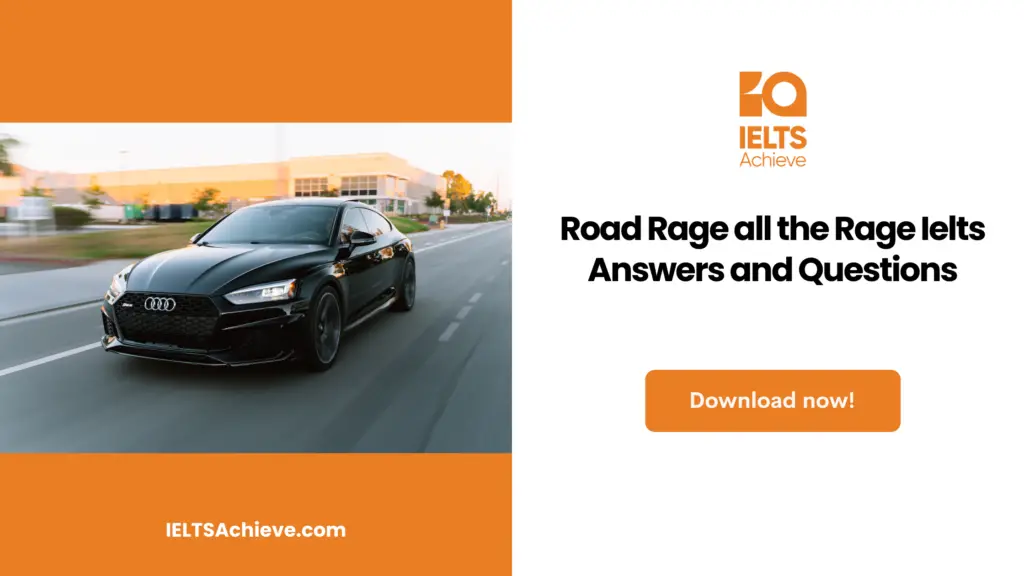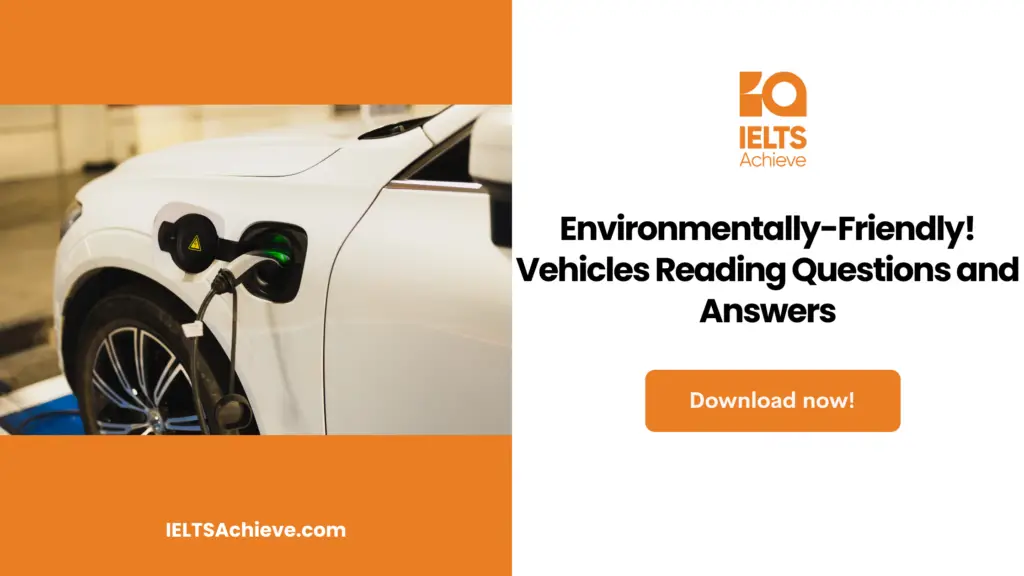The Blog post contains the following IELTS Reading Questions:
- IELTS Reading Table Completion
- IELTS Reading True/False/Not Given
- IELTS Reading Sentence Completion
- IELTS Reading Multiple choice questions
Stay informed and prepared for success – Explore our comprehensive Reading Test Info page to get valuable insights, exam format details, and expert tips for mastering the IELTS Reading section.
IELTS reading passage – Road Rage all the Rage

Road Rage all the Rage
Many people associate the phrase “Road Rage” with a relatively new concept of drivers “becoming heated up due to some occurrence on the road and resorting to physical violence or property damage.” Most people believe that this has existed only since the last five years or so. It has certainly piqued the media’s eye recently, but it has been a part of motoring for quite some time.
The Royal Automobile Club (RAC) employs a psychologist who describes ‘Road Rage’ as “unchecked behaviour aimed to do injury to another road user; behaviour that is not ordinarily in the person’s behavioural repert.” ‘Road Rage’ is a change in personality triggered by a dehumanisation process that occurs while driving. This dehumanisation is generated by road frustrations and the car’s illusory sensation of insulation, protection, and empowerment. This causes the person to act in a way that is intended to inflict injury or endanger other road users.
Most motorists can recall an instance when an impatient or short-tempered driver ‘cut them or someone else up’ with an aggressive display of driving, prompting the victim to take evasive action to avoid a collision. They undoubtedly thought to themselves at the time: what a dreadful bit of driving; and mentally slapped themselves on the back for being such controlled, calm drivers. This type of driving has gained recognition as a result of media attention focused on particularly heinous events. As a professional driver in central London and a motorbike instructor, I’ve seen far too much of this over the years.
The Lex Service PLC, the UK’s premier vehicle retailing and leasing firm, produced the 1996 Lex Report on motoring, which contains some surprising figures. There have been 1.8 million instances of people being forced to pull over or off the road in the last 12 months; 800,000 instances of people being physically threatened; 500,000 people in their cars being deliberately driven into; 250,000 people being attacked by other drivers; and 250,000 people having their cars intentionally damaged by another driver. A Lex survey also indicates that up to 80% of motorists have been victims of Road Ragje’ and that driver confrontation is on the rise.
The RAC has a lot to say about it as well. According to one of their polls, up to 90% of motorists have suffered at the hands of highly anti-social drivers, and the consequences have been totally disproportionate to the level of threat or actual violence inflicted.
The illustrationns are both chilling and legion: a driver had his nose bitten off following a row along with another motorist; a 78-year-old man was killed after being punched by a man half his age; a RAC patrolman, flagged down on the motorway by a motorist, was violently assaulted and verbally abused by the motorist. The list goes on and on.
The 1991 Road Traffic Act takes a dim view of risky and careless driving and, like assaults, imposes harsh jail penalties on people who commit such offenses. However, there is currently no such charge in the statute books known as “Road Rage.” There can be attacks or criminal damage, followed or preceded by unsafe driving, but no offense that combines the two – a reform in the law that the public is demanding in the face of increasing chaos on the roads.
The Association of Chief Police Officers, on the other hand, disputes that ‘Road Rage’ exists or that there is a trend. According to the same source, “media interest and reporting are, in reality, driving the problem by raising undue anxiety in the minds of the motoring public in a clear similarity with criminal dread.”
Most of us undoubtedly believe that road rage is solely a male preserve, as men are inherently more competitive and aggressive, especially when it comes to driving. ‘Women can be more violent in cars than they ever would be going down the street,’ according to Melanie Flowers of Oxford Brookes University. In fact, you could argue that smaller or weaker people, who may be victims outside of their cars, typically believe they can balance things out behind the wheel. When driving, your car is appraised rather than your personal characteristics. It makes some women feel more powerful than they are. A fascinating study, but how often do you see women fighting on the side of the road or kicking in body panels?
If this is a general depiction of the 1990s driver, then the professionals have an uphill struggle. They are, however, confronting the issue head-on. The RAC and the automotive magazine Auto Express have joined forces in a Campaign Against Rage (CAR). They want to promote driver civility and give tips on how to avoid ‘Road Rage’ and even Rage. Rehabilitation for violent offenders in order to prevent recidivism.
The courts are going for stiffer penalties. The RAC also suggests that sign-posting be enhanced to prevent city drivers from becoming lost, which is a persistent source of anger and aggressiveness, and that varied message signs be introduced to help improve driving behavior. Some police traffic control vehicles now have these message signs mounted on the roof or rear of their vehicles.
And what about the future? According to the Auto Class Survey, published in 1997, parents are raising the next generation of road ragers. According to a study of 10-16-year-olds, 62% of fathers and 55% of moms became upset while driving. One thing is a certainty: the Road Rage phenomenon is definitely not going to disappear overnight, even after stiffer sentencing or improved driver training.
Unlock your full potential in the IELTS Reading section – Visit our IELTS Reading Practice Question Answer page now!
Recommended Questions:
Renewable Energy IELTS Reading Question with Answer
Road Rage all the Rage reading questions
Questions 1 & 2
Using the Information in the passage, complete the table below. Write your answers in boxes 1 & 2 on your answer sheet.
Percentage of motorists affected by Road Rage
The Lex Report – up to 1________%
RAC Survey – up to 2________%
Boost your performance in Summary, Notes, Table, and Flowchart Completion tasks. Click here to explore our detailed guide and learn how to effectively complete summaries, notes, tables, and flowcharts in the IELTS Reading section.
Questions 3-8
Do the following statements agree with the information given in the reading passage? In boxes 3-8 on your answer sheet, write
TRUE if the statement is true
FALSE if the statement is false
NOT GIVEN if the information is not given in the passage.
3. Road Rage is not in itself a violation of the law.
4. According to a psychologist employed by the RAC, cars give their drivers an unreal feeling of being safe.
5. Motorcycling is exciting, but a safe mode of transport.
6. The Lex Report states that the incidence of conflicts between drivers is rising rapidly.
7. The survey on Road Rage carried out by the RAC is very thorough.
8. According to the writer, Road Rage is a relatively modern phenomenon.
Enhance your skills in identifying information as True, False, or Not Given. Click here to discover expert strategies and techniques for mastering this question type in the IELTS Reading section.
Questions 9-11
Using NO MORE THAN THREE WORDS from the passage, complete the sentences below.
9. Professionals face an ________ in their fight against Road Rage.
10. _________ are being considered by the law courts.
11. Violent behaviour by motorists is, in all probability, considered by many to be exclusively a _________
Enhance your sentence completion skills in the IELTS Reading section. Click here to access our comprehensive guide and learn effective strategies for filling in missing words or phrases in sentences.
Questions 12 & 13
Choose the appropriate letters A-D and write them in Boxes 12 and 13 on your answer sheet.
12. Melanie Flowers of Oxford Brookes University states that…
- Cars make women stronger.
- Cars frequently make women more combative than usual.
- Cars sometimes make women less meek than they would be on the street.
- Small women feel as meek in cars as they do outside.
13. The writer’s view of the eradication of ‘Road Rage’ can be summarised as follows:
A. optimistic.
B. pessimistic.
C. depressed.
D. too pessimistic
Ready to improve your performance in Multiple Choice Questions (MCQs)? Click here to access our comprehensive guide on how to tackle MCQs effectively in the IELTS Reading section.
Unlock your full potential in the IELTS Reading section – Visit our IELTS Reading Practice Question Answer page now!
Recommended Questions:
Renewable Energy IELTS Reading Question with Answer
Road Rage all the Rage reading answers
1. 80
2. 90
3. YES
4. YES
5. NOT GIVEN
6. NOT GIVEN
7. NOT GIVEN
8. NO
9. UPHILL STRUGGLE
10. STIFFER PENALTIES/ STIFFER SENTENCES
11. MALE PRESERVE
12. C
13. B

We hope you found this post useful in helping you to study for the IELTS Test. If you have any questions please let us know in the comments below or on the Facebook page.
The best way to keep up to date with posts like this is to like us on Facebook, then follow us on Instagram and Pinterest. If you need help preparing for the IELTS Test, join the IELTS Achieve Academy and see how we can assist you to achieve your desired band score. We offer an essay correction service, mock exams and online courses.

